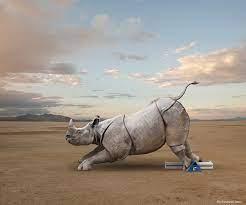I’ll preface this post with a caveat — the data herein are a few years old (certainly pre-COVID), so things have likely changed a bit. Still, I think the main message holds.
Many years ago, I compiled seven different national-level measures of environmental degradation to show that countries with the largest human populations, and hence, the largest economies, had done the most environmental damage — not only to their own resources, but to the world’s in general.

That last observation is important because there are really two main ways to quantify a country’s environmental performance. First, there is its relative environmental damage, which essentially means what proportion of its own resources a country has pilfered or damaged. This type of measure standardises the metrics to account for the different areas of countries (e.g., Russia versus Singapore) and how much of, say, forests, they had to start with, and what proportion of them they have thus far destroyed.
Looking at it this way, small countries with few large-scale industries came out in the lead as the least-damaged environmentally — the least environmentally damaged country according this metric is Cape Verde (followed by Central African Republic, Swaziland, Niger, and Djibouti).
However, another way to look at it is how much of the overall contribution to the world’s environmental damage each country is responsible, which of course implies that the countries with the highest amounts of resources damaged in absolute terms (i.e., the biggest, most populous ones) disproportionately contribute more to global environmental damage.
Using this absolute metric, the countries with the greatest overall damage are Brazil (largely due to the destruction of the Amazon and its other forests), the USA (for its greenhouse-gas emissions and conversion of its prairies to farmland), and China (for its water pollution, deforestation, and carbon emissions). On the flip side, this means that the smallest countries with the fewest people are ranked ‘better’ because of their lower absolute contribution to the world’s total environmental damage.
Looking more closely at how countries do relative to each other using different and more specific measures of environmental performance, the best-known and most-reported metric is the ecological footprint. This measures the ecological ‘assets’ that any particular population of people requires to produce the natural resources it consumes and to absorb its wastes.
There are six main categories of such natural resources that make up the main footprint for each nation, meaning that it tracks the per capita use by a nation’s population of both domestic and foreign consumption of croplands, grazing lands, fishing areas, built-up land, forest area, and carbon demand on land (i.e., land required to store the carbon emitted to the atmosphere).
While the implications of using the ecological footprint for environmental policies might have limitations, it appears to be a reasonable metric for assessing the relative global impact of different countries on the environment.

But just like the relative environmental metric above, the ecological footprint places small, under-developed nations as the best environmental performers — in fact, Timor-Leste has the lowest footprint today. But there is clearly a problem with this sort of metric when we look at the third-best performer — Haiti. Haiti is infamous for having demolished most of its forests, nor would a visitor easily develop the impression that the country is a good custodian of its environmental resources. Thus, a low ecological footprint here simply means that due to a country’s advanced poverty, it does not have a large impact on the world’s total resources. This is hardly surprising.
At the other end of the spectrum, the worst performers (i.e., largest ecological footprint) are ‘wealthy’ countries, with Luxembourg leading the pack mainly because its citizens require so much of the world’s resources to keep them at the standard of wasteful living to which they have become accustomed. Australia, Canada, USA, and Singapore follow.
Perhaps a more insightful way to compare countries is to group them into geographically or economically similar categories. For example, if we look at the ecological-footprint ranking of the 41 countries making up the Organisation of Economic Co-operation and Development (OECD), the country with the smallest footprint is Mexico. Again, the reasons for the rankings appear economically obvious. By region, the smallest ecological footprints are found in Eritrea for Africa, Romania for Europe, Timor-Leste for Asia, Yemen for the Middle East, Papua New Guinea for Oceania, Haiti for the Caribbean, Nicaragua for North and Central America, and Colombia for South America
Another potentially useful metric is just how much of a country’s land (or sea) its government sets aside to protect its natural heritage and resources. While this might not necessarily cover all the aspects of ‘environment’ we need to explore, we do know that the more emphasis a country places on protecting its biodiversity, the more it actually achieves this goal.

Although the proportion of area protected within a country is not a perfect reflection of its environmental performance, it tends to indicate to what extent its government, and therefore, its people, are committed to saving its natural heritage. If we exclude some small-island nations with relatively little total land area, the countries with the highest proportions of land under some form of protection is led by Venezuela, with over half (54%) of its land under some form of protection. Slovenia, Bhutan, Leichtenstein, Brunei, Bulgaria, and Namibia follow.
But just because a country claims to protect its environment does not necessarily mean it succeeds in doing so. Another metric is forest loss, and while it might seem a straight-forward thing to measure, in reality, it is more complex. The first problem is that many forests are distant from public view, or they are in remote and difficult-to-access regions. Another is that some countries even lie about how much forest they have left. Then there is the issue of historical versus modern forest loss — for example, do we count the deforestation done in Spain, Italy, and Britain during the Roman era, or perhaps the extensive forest loss in India during British occupation?
We will probably never really be able to tell what was forested and what was not millennia or even centuries ago, but we do have the advantage in the modern era of satellite data that at least can tell us about the gross magnitude of recent change in forest cover. Luckily, we have data on ‘recent’ forest-cover loss at a global scale, correcting for all sorts of measurement biases and scale issues. At least since 2000, the countries with the highest rates of native forest-cover loss are Paraguay, Guatemala, Malaysia, Cambodia, and Nicaragua.
Another metric to consider is arguably one of the most important of all when assessing a country’s relative environmental rank. While far from complete, the International Union for the Conservation of Nature (IUCN) is an international body that takes the heavy responsibility of measuring threat to the world’s species. Their signature assessment tool is the Red List of Threatened Species, and is easily the gold standard of a species’ relative ‘threat’ risk (i.e., the likelihood that it will go extinct in the foreseeable future).
While there are many categories of relative threat, from ‘Near Threatened’ all the way up to ‘Critically Endangered’ and ‘Extinct in the Wild’, the proportion of a country’s assessed species considered under some sort of threat of imminent extinction indicates that the country with the lowest proportion of its species considered threatened with extinction is Central African Republic (followed by South Sudan, Aruba, Swaziland, and Botswana), whereas, the worst country according to this index is Singapore (followed by New Zealand, Spain, Seychelles, and Madagascar).

With so many indices, it’s difficult to know what to use to examine relative performance. And with climate change ramping up, we’re all doing badly no matter which country you’re from. Hopefully some nations can avoid the worst of the extinction crisis by fixing addressing some of the main contributors to poor environmental performance.
CJA Bradshaw

